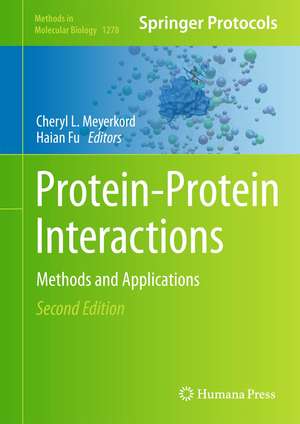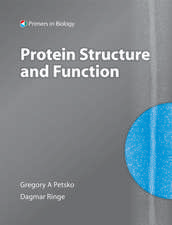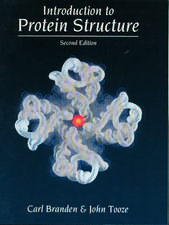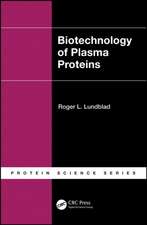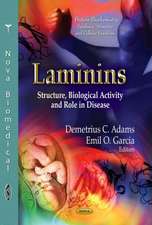Protein-Protein Interactions: Methods and Applications: Methods in Molecular Biology, cartea 1278
Editat de Cheryl L. Meyerkord, Haian Fuen Limba Engleză Hardback – 10 apr 2015
Authoritative and cutting-edge, Protein-Protein Interactions: Methods and Applications, Second Edition is a valuable resource that will enable readers to elucidate the mechanisms of protein-protein interactions, determine the role of these interactions in diverse biological processes, and target protein-protein interactions for therapeutic discovery.
Din seria Methods in Molecular Biology
- 9%
 Preț: 791.59 lei
Preț: 791.59 lei - 23%
 Preț: 598.56 lei
Preț: 598.56 lei - 20%
 Preț: 882.95 lei
Preț: 882.95 lei -
 Preț: 252.04 lei
Preț: 252.04 lei - 5%
 Preț: 729.61 lei
Preț: 729.61 lei - 5%
 Preț: 731.43 lei
Preț: 731.43 lei - 5%
 Preț: 741.30 lei
Preț: 741.30 lei - 5%
 Preț: 747.16 lei
Preț: 747.16 lei - 15%
 Preț: 663.45 lei
Preț: 663.45 lei - 18%
 Preț: 1025.34 lei
Preț: 1025.34 lei - 5%
 Preț: 734.57 lei
Preț: 734.57 lei - 18%
 Preț: 914.20 lei
Preț: 914.20 lei - 15%
 Preț: 664.61 lei
Preț: 664.61 lei - 15%
 Preț: 654.12 lei
Preț: 654.12 lei - 18%
 Preț: 1414.74 lei
Preț: 1414.74 lei - 5%
 Preț: 742.60 lei
Preț: 742.60 lei - 20%
 Preț: 821.63 lei
Preț: 821.63 lei - 18%
 Preț: 972.30 lei
Preț: 972.30 lei - 15%
 Preț: 660.49 lei
Preț: 660.49 lei - 5%
 Preț: 738.41 lei
Preț: 738.41 lei - 18%
 Preț: 984.92 lei
Preț: 984.92 lei - 5%
 Preț: 733.29 lei
Preț: 733.29 lei -
 Preț: 392.58 lei
Preț: 392.58 lei - 5%
 Preț: 746.26 lei
Preț: 746.26 lei - 18%
 Preț: 962.66 lei
Preț: 962.66 lei - 23%
 Preț: 860.21 lei
Preț: 860.21 lei - 15%
 Preț: 652.64 lei
Preț: 652.64 lei - 5%
 Preț: 1055.50 lei
Preț: 1055.50 lei - 23%
 Preț: 883.85 lei
Preț: 883.85 lei - 19%
 Preț: 491.88 lei
Preț: 491.88 lei - 5%
 Preț: 1038.84 lei
Preț: 1038.84 lei - 5%
 Preț: 524.15 lei
Preț: 524.15 lei - 18%
 Preț: 2122.34 lei
Preț: 2122.34 lei - 5%
 Preț: 1299.23 lei
Preț: 1299.23 lei - 5%
 Preț: 1339.10 lei
Preț: 1339.10 lei - 18%
 Preț: 1390.26 lei
Preț: 1390.26 lei - 18%
 Preț: 1395.63 lei
Preț: 1395.63 lei - 18%
 Preț: 1129.65 lei
Preț: 1129.65 lei - 18%
 Preț: 1408.26 lei
Preț: 1408.26 lei - 18%
 Preț: 1124.92 lei
Preț: 1124.92 lei - 18%
 Preț: 966.27 lei
Preț: 966.27 lei - 5%
 Preț: 1299.99 lei
Preț: 1299.99 lei - 5%
 Preț: 1108.51 lei
Preț: 1108.51 lei - 5%
 Preț: 983.72 lei
Preț: 983.72 lei - 5%
 Preț: 728.16 lei
Preț: 728.16 lei - 18%
 Preț: 1118.62 lei
Preț: 1118.62 lei - 18%
 Preț: 955.25 lei
Preț: 955.25 lei - 5%
 Preț: 1035.60 lei
Preț: 1035.60 lei - 18%
 Preț: 1400.35 lei
Preț: 1400.35 lei - 20%
 Preț: 817.30 lei
Preț: 817.30 lei
Preț: 1411.25 lei
Preț vechi: 1721.04 lei
-18% Nou
Puncte Express: 2117
Preț estimativ în valută:
270.07€ • 280.25$ • 225.73£
270.07€ • 280.25$ • 225.73£
Carte tipărită la comandă
Livrare economică 18 martie-01 aprilie
Preluare comenzi: 021 569.72.76
Specificații
ISBN-13: 9781493924240
ISBN-10: 1493924249
Pagini: 620
Ilustrații: XV, 620 p. 139 illus., 70 illus. in color.
Dimensiuni: 178 x 254 x 32 mm
Greutate: 1.31 kg
Ediția:2nd ed. 2015
Editura: Springer
Colecția Humana
Seria Methods in Molecular Biology
Locul publicării:New York, NY, United States
ISBN-10: 1493924249
Pagini: 620
Ilustrații: XV, 620 p. 139 illus., 70 illus. in color.
Dimensiuni: 178 x 254 x 32 mm
Greutate: 1.31 kg
Ediția:2nd ed. 2015
Editura: Springer
Colecția Humana
Seria Methods in Molecular Biology
Locul publicării:New York, NY, United States
Public țintă
Professional/practitionerCuprins
Structural basis of protein-protein interactions.- Quantitative analysis of protein-protein interactions.- Protein-protein interaction databases.- Computational prediction of protein-protein interactions.-- Structure-based computational approaches for small-molecule modulation of protein-protein interactions.- Targeting protein-protein interactions for drug discovery.- Studying protein-protein interactions using surface plasmon resonance.- Resonant waveguide grating for monitoring bimolecular interactions.- Quartz microbalance technology for probing biomolecular interactions.- Label-free kinetic analysis of an antibody-antigen interaction using biolayer interferometry.- Characterization of protein-protein interactions by isothermal titration calorimetry.- Sedimentation equilibrium studies.- Detecting protein-protein interactions by gel filtration chromatography.- Using light scattering to determine the stoichiometry of protein complexes.- Circular dichroism (CD) analyses of protein-protein interactions.- Protein-protein interaction analysis by nuclear magnetic resonance spectroscopy.- Quantitative protein analysis by mass spectrometry.- Using peptide arrays created by the SPOT method for defining protein-protein interactions.- Fluorescence polarization assay to quantify protein-protein interactions.- Förster resonance energy transfer (FRET) microscopy for monitoring biomolecular interactions.- Utilizing ELISA to monitor protein-protein interactions.- Glutathione-S-transferase (GST)-fusion based assays for studying protein-protein interactions.- Hexahistidine (6xHis) fusion-based assays for protein-protein interactions.- Studying protein-protein interactions via blot overlay/Far Western blot.- Co-immunoprecipitation from transfected cells.- In vivo protein cross-linking.- Identification of protein-protein interactions by standard Gal4p-based yeast two-hybrid screening.- Reverse two-hybrid techniques in the yeast Saccharomyces cerevisiae .-MAPPIT, a mammalian two-hybrid method for in-cell detection of protein-protein interactions.- Bioluminescence resonance energy transfer to detect protein-protein interactions in live cells.- Mapping biochemical networks with protein fragment complementation assays.- Detection of protein-protein interaction using bimolecular fluorescence complementation assay.- Split-luciferase complementation assay to detect channel-protein interactions in live cells.- Confocal microscopy for intracellular co-localization of proteins.- Fluorescence polarization assay to quantify protein-protein interactions in an HTS format.- Estrogen receptor alpha/co-activator interaction assay - TR-FRET.- High content screening biosensor assay to identify disruptors of p53-hDM2 protein-protein interactions.- Discovery of inhibitors of the MDM2-p53 protein-protein interaction.- Biophysical methods for identifying fragment-based inhibitors of protein-protein interactions.
Textul de pe ultima copertă
In recent years, our understanding of the protein-protein interaction landscape has expanded significantly. Growing interest in analyzing and targeting protein-protein interactions has resulted in an increased need for detailed methodologies to interrogate and monitor protein-protein interactions. To meet this need, Protein-Protein Interactions: Methods and Applications has been updated and expanded. The second edition includes core technological platforms used to study protein-protein interactions, and cutting-edge technologies that reflect recent scientific advances and the emerging focus on therapeutic discovery. Written in the highly successful Methods in Molecular Biology series format, chapters include introductions to their respective topics, lists of necessary materials and reagents, step-by-step laboratory protocols, and tips on troubleshooting and avoiding known pitfalls. These well-detailed protocols describe methods for identifying protein-protein interaction partners, analyzing protein-protein interactions quantitatively and qualitatively, monitoring protein-protein interactions in live cells, and predicting and determining interaction interfaces.
Authoritative and cutting-edge, Protein-Protein Interactions: Methods and Applications, Second Edition is a valuable resource that will enable readers to elucidate the mechanisms of protein-protein interactions, determine the role of these interactions in diverse biological processes, and target protein-protein interactions for therapeutic discovery.
Authoritative and cutting-edge, Protein-Protein Interactions: Methods and Applications, Second Edition is a valuable resource that will enable readers to elucidate the mechanisms of protein-protein interactions, determine the role of these interactions in diverse biological processes, and target protein-protein interactions for therapeutic discovery.
Caracteristici
Includes cutting-edge methods and protocols Provides step-by-step detail essential for reproducible results Contains key notes and implementation advice from the experts
